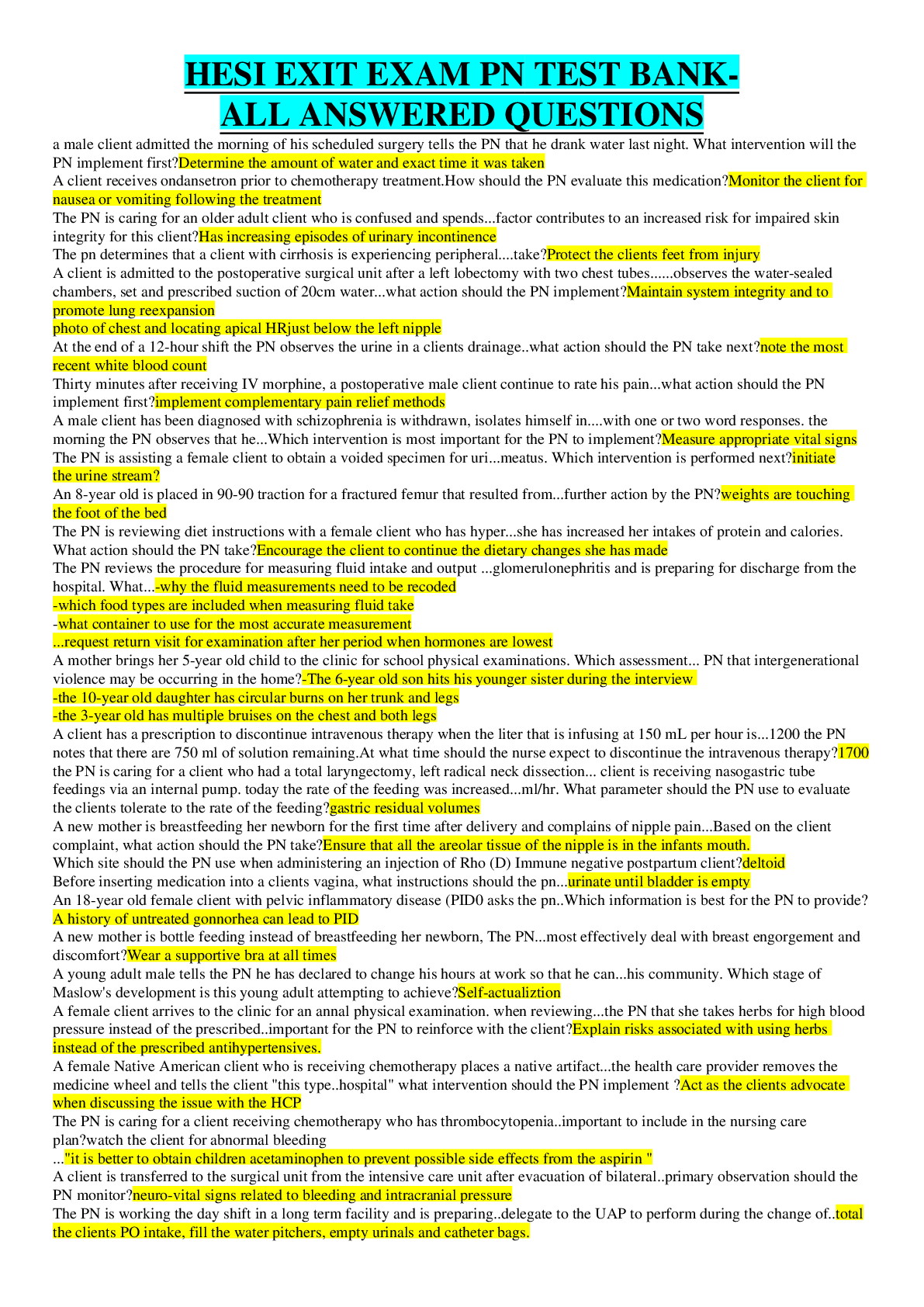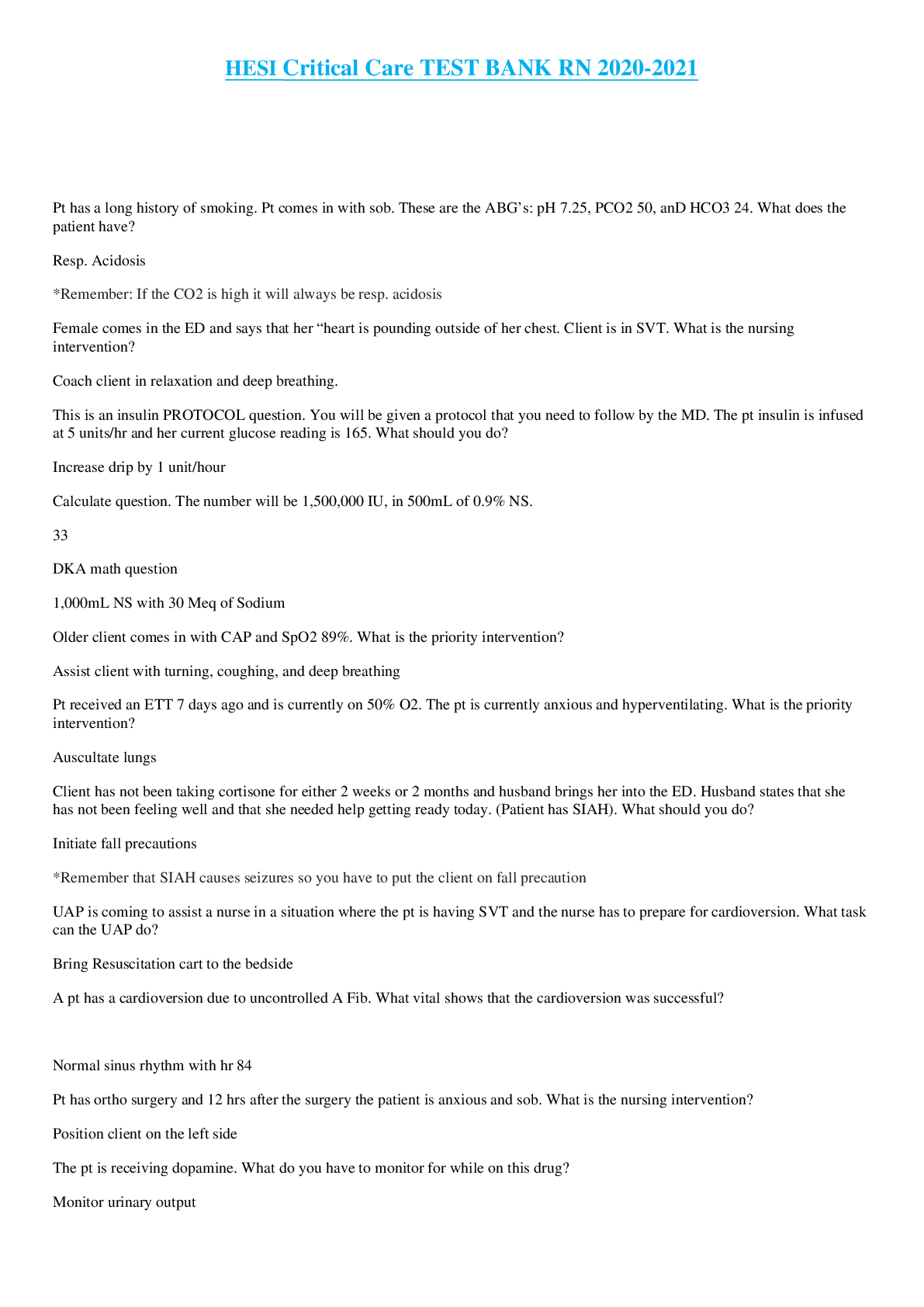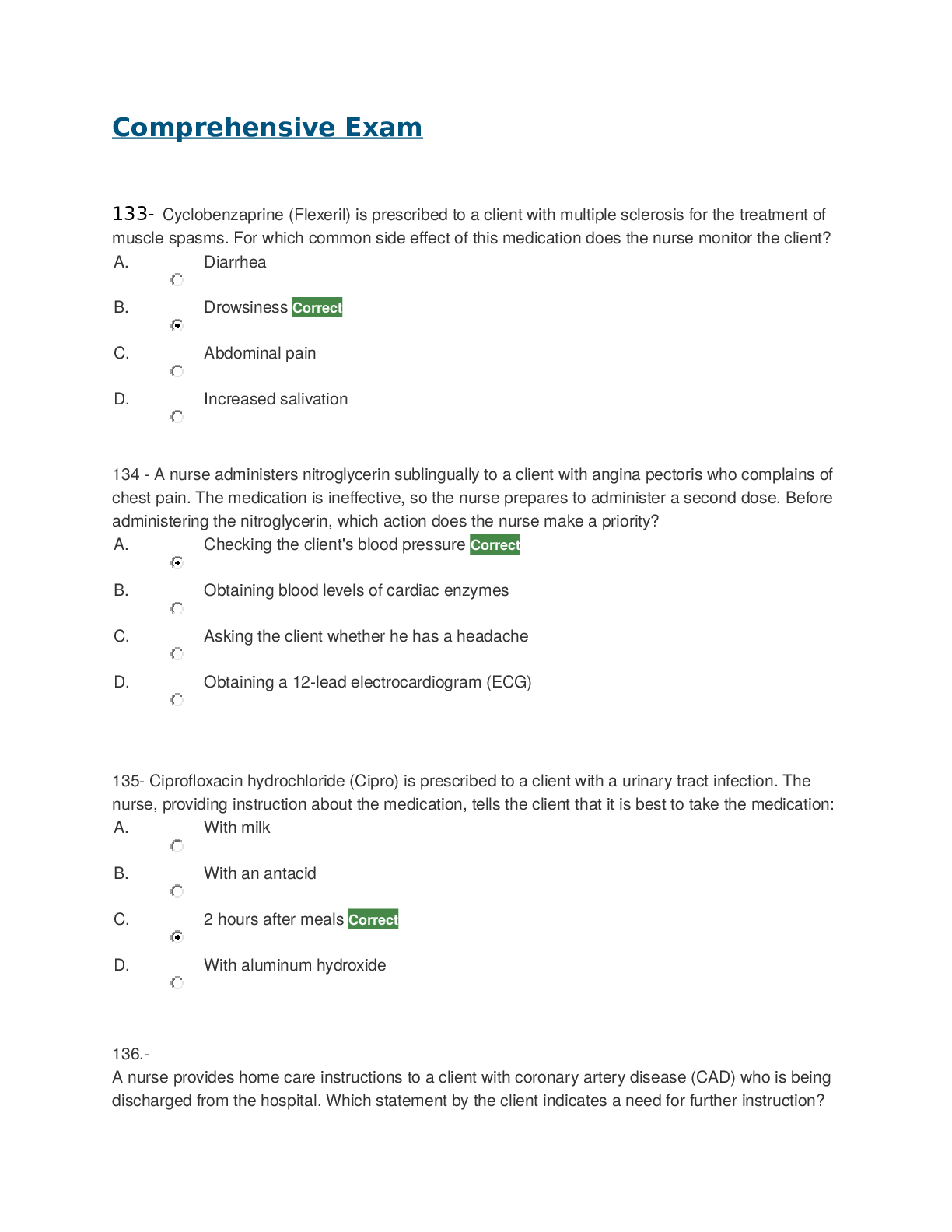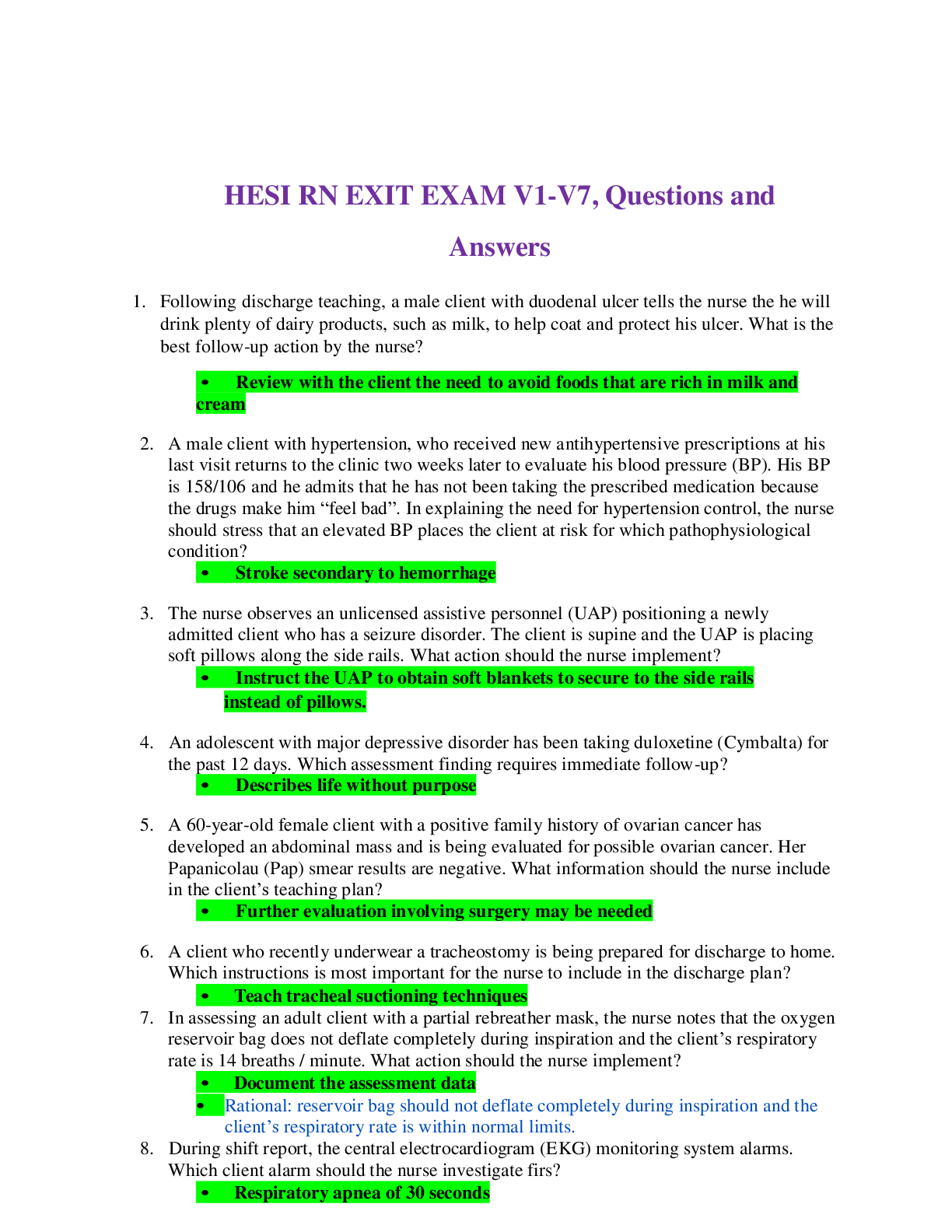HESI Maternity 2 Latest 2021 Graded A+
Document Content and Description Below
HESI Maternity 2 Latest 2021 Graded A+ Which nursing intervention is most helpful in relieving postpartum uterine contractions or "afterpains?" a. Lying prone with a pillow on the abdomen b. Usin... g a breast pump c. Massaging the abdomen d. Giving oxytocic medications A multigravida client arrives at the labor and delivery unit and tells the nurse that her bag of water has broken. The nurse identifies the presence of meconium fluid on the perineum and determines the fetal heart rate is between 140 to 150 beats/minute. What action should the nurse implement next? a. Complete a sterile vaginal exam b. Take maternal temperature every 2 hours c. Prepare for an immediate cesarean birth d. Obtain sterile suction equipment When explaining "postpartum blues" to a client who is 1 day postpartum, which symptoms should the nurse include in the teaching plan? (Select all that apply.) a. Mood swings b. Panic attacks c. Tearfulness d. Decreased need for sleep e. Disinterest in the infant A client at 30-weeks gestation, complaining of pressure over the pubic area, is admitted for observation. She is contracting irregularly and demonstrates underlying uterine irritability. Vaginal examination reveals that her cervix is closed, thick, and high. Based on these data, which intervention should the nurse implement first? a. Provide oral hydration b. Have a complete blood count (CBC) drawn c. Obtain a specimen for urine analysis d. Place the client on strict bedrest A client in active labor complains of cramps in her leg. What intervention should the nurse implement? a. Ask the client if she takes a daily calcium tablet b. Extend the leg and dorsiflex the foot c. Lower the leg off the side of the bed d. Elevate the leg above the heart The nurse is caring for a woman with a previously diagnosed heart disease who is in the second stage of labor. Which assessment findings are of greatest concern? a. edema, basilar rales, and an irregular pulse b. Increased urinary output, and tachycardia c. Shortness of breath, bradycardia, and hypertension d. Regular heart rate, and hypertension The nurse is teaching a woman how to use her basal body temperature (BBT) pattern as a tool to assist her in conceiving a child. Which temperature pattern indicates the occurrence of ovulation, and therefor, the best time for intercourse to ensure conception? a. Between the time the temperature falls and rises b. Between 36 and 48 hours after the temperature rises c. When the temperature falls and remains low for 36 hours d. Within 72 hours before the temperature falls A client who is in the second trimester of pregnancy tells the nurse that she wants to use herbal therapy. Which response is best for the nurse to provide? a. Herbs are a corner stone of good health to include in your treatment b. Touch is also therapeutic in relieving discomfort and anxiety c. Your healthcare provider should direct treatment options for herbal therapy d. It is important that you want to take part in your care A mother who is breastfeeding her baby receives instructions from the nurse. Which instruction is most effective to prevent nipple soreness? a. Wear a cotton bra b. Increase nursing time gradually c. Correctly place the infant on the breast d. Manually express a small amount of milk before nursing The nurse is counseling a woman who wants to become pregnant. The woman tells the nurse that she has a 36-day menstrual cycle and the first day of her menstrual period was January *. The nurse correctly calculates that the woman's next fertile period is a. January 14-15 b. January 22-23 c. January 30-31 d. February 6-7 The nurse should encourage the laboring client to begin pushing when a. there is only an anterior or posterior lip of cervix left b. the client describes the need to have a bowel movement c. the cervix is completely dilated d. the cervix is completely effaced One hour after giving birth to an 8-pound infant, a client's lochia rubra has increased from small to large and her fundus is boggy despite massage. The client's pulse is 84 beats/minute and blood pressure is 156/96. The healthcare provider prescribes Methergine 0.2 mg IM x 1. What action should the nurse take immediately? a. Give the medication as prescribed and monitor for efficacy b. Encourage the client to breastfeed rather than bottle feed c. Have the client empty her bladder and massage the fundus d. Call the healthcare provider to question the prescription A newborn, whose mother is HIV positive, is scheduled for follow-up assessments. The nurse knows that the most likely presenting symptom for a pediatric client with AIDS is: a. shortness of breath b. joint pain c. a persistent cold d. organomegaly A healthcare provider informs the charge nurse of a labor and delivery unit that a client is coming to the unit with suspected abruptio placentae. What findings should the charge nurse expect the client to demonstrate? (Select all that apply) a. Dark, red vaginal bleeding b. Lower back pain c. Premature rupture of membranes d. Increased uterine irritability e. Bilateral pitting edema f. A rigid abdomen The nurse assesses a client admitted to the labor and delivery unit and obtains the following data: dark red vaginal bleeding, uterus slightly tense between contractions, BP 110/68, FHR 110 beats/minute, cervix 1 cm dilated and uneffaced. Based on these assessment findings, what intervention should the nurse implement? a. Insert an internal fetal monitor b. Assess for cervical changes q1h c. Monitor bleeding from IV sites d. Perform Leopold's maneuvers A client who is attending antepartum classes asks the nurse why her healthcare provider has prescribed iron tablets. The nurse's response is based on what knowledge? a. Supplementary iron is more efficiently utilized during pregnancy b. It difficult to consume 18 mg of additional iron by diet alone c. Iron absorption is decreased in the GI tract during pregnancy d. Iron is needed to prevent megaloblastic anemia in the last trimester A 42-week gestational client is receiving an intravenous infusion of oxytocin (Pitocin) to augment early labor. The nurse should discontinue the oxytocin infusion for which pattern of contractions? a. Transition labor with contractions every 2 minutes, lasting 90 seconds each a. Early labor with contractions every 5 minutes, lasting 40 seconds each c. Active labor with contractions every 31 minutes, lasting 60 seconds each d. Active labor with contractions every 2 to 3 minutes, lasting 70 to 80 seconds each Which maternal behavior is the nurse most likely to see when a new mother receives her infant for the first time? a. She eagerly reaches for the infant, undresses the infants, and examines the infant completely b. Her arms and hands receive the infant and she then traces the infant's profile with her fingertips c. Her arms and hands receive the infant and she then cuddles the infant to her own body d. She eagerly reaches for the infant and then holds the infant close to her own body Client teaching is an important part of the maternity nurse's role. Which factor has the greatest influence on successful teaching on the gravid client? a. The client's readiness to learn b. The client's educational background c. The order in which the information is presented d. The extent to which the pregnancy was planned During labor, the nurse determines that a full-term client is demonstrating late decelerations. In which sequence should the nurse implement these nursing actions? (Arrange in order) a. Provide oxygen via face mask b. Reposition the client c. Increase IV fluid d. Call the healthcare provider The nurse is teaching care of the newborn to a group of prospective parents and describes the need for administering antibiotic ointment into the eyes of the newborn. Which infectious organism will this treatment prevent from harming the infant? a. Herpes b. Staphylococcus c. Gonorrhea d. Syphilis The nurse identifies crepitus when examining the chest of a newborn who was delivered vaginally. Which further assessment should the nurse perform? a. Elicit positive scarf sign on the affected side b. Observe for an asymmetrical Moro (startle) reflex c. Watch for swelling of fingers on the affected side d. Note paralysis of affected extremity and muscles The nurse is calculating the estimated date of confinement (EDC) using Nagele's rule for a client whose last menstrual period started on December 1. Which date is most accurate? a. August 1 b. August 10 c. September 3 d. September 8 A woman who had a miscarriage 6 months ago becomes pregnant. Which instruction is most important is most important for the nurse to provide this client? a. Elevate lower legs while resting b. Increase caloric intake by 200 to 300 calories per day c. Increase water intake to 8 full glasses per day d. Take prescribed multivitamin and mineral supplements The total bilirubin level of a 36-hour, breastfeeding newborns is 14 mg/dl. Based on this finding, which intervention should the nurse implement? a. Provide phototherapy for 30 minutes q8h b. Feed the newborn sterile water hourly c. Encourage the mother to breastfeed frequently d. Assess the newborn's blood glucose level c. Encourage the mother to breastfeed frequently Which assessment finding should the nursery nurse report to the pediatric healthcare provider? a. Blood glucose level of 45 mg/dl b. Blood pressure of 82/45 mmHg c. Non-bulging anterior fontanel d. Central cyanosis when crying A client who gave birth to a healthy 8-pound infant 3 hours ago is admitted to the postpartum unit. Which nursing plan is best in assisting this mother to bond with her newborn infant? a. Encourage the mother to provide total care for her infant b. Provide privacy, so the mother can develop a relationship with the infant c. Encourage the father to provide most of the infant's care during hospitalization d. Meet the mother's physical needs and demonstrate warmth toward the infant A client receiving epidural anesthesia begins to experience nausea and becomes pale and clammy. What intervention should the nurse implement first? a. Raise the foot of the bed b. Assess for vaginal bleeding c. Evaluate the fetal heart rate d. Take the client's blood pressure The nurse is providing discharge teaching for a client who is 24 hours postpartum. The nurse explains to the client that her vaginal discharge will change from red to pink and then to white. The client asks, "What if I start having red bleeding after it changes?" What should the nurse instruct the client to do? a. Reduce activity level and notify the healthcare provider b. Go to bed and assume a knee-chest position c. Massage the uterus and go to the emergency room d. Do not worry as this is a normal occurrence A pregnant client with mitral stenosis Class III is prescribed complete bedrest. The client asks the nurse, "Why must I stay in bed all the time?" Which response is best for the nurse to provide this client? a. Complete bedrest decreases oxygen needs and demands on the heart muscle b. We want your baby to be healthy, and this is the only way we can make sure that will happen again c. I know you're upset. Would you like to talk about somethings you could so while in bed? d. Labor is difficult, and you need to use this time to rest before you have to assume all child-caring duties A pregnant woman comes to the prenatal clinic for an initial visit. In reviewing her childbearing history, the client indicated that she has delivered premature twins, one full-term baby, and has had no abortions. Which GTPAL should the nurse document in this client's record? a. 3-1-2-0-3 b. 4-1-2-0-3 c. 2-1-2-1-2 d. 3-1-1-0-3 A client at 32-weeks gestation comes to the prenatal clinic with complaints of pedal edema, dyspnea, fatigue, and a moist cough. Which question is most important for the nurse to ask this client? a. Which symptom did you experience first? b. Are you eating large amounts of salty foods? c. Have you visited a foreign country recently? d. Do you have a history of rheumatic fever? A 35-year-old primigravida client with severe preeclampsia is receiving magnesium sulfate via continuous IV infusion. Which assessment data indicates to the nurse that the client is experiencing magnesium sulfate toxicity? a. Deep tendon reflexes 2+ b. Blood pressure 140/90 c. Respiratory rate 18/minute d. Urine output 90 ml/4 hours A client is admitted with the diagnosis of total placenta previa. Which finding is most important for the nurse to report to the healthcare provider immediately? a. Heart rate of 100 beats/minute b. Variable fetal heart rate c. Onset of uterine contractions d. Burning urination [Show More]
Last updated: 1 year ago
Preview 1 out of 11 pages

Reviews( 0 )
Document information
Connected school, study & course
About the document
Uploaded On
Mar 11, 2021
Number of pages
11
Written in
Additional information
This document has been written for:
Uploaded
Mar 11, 2021
Downloads
0
Views
44

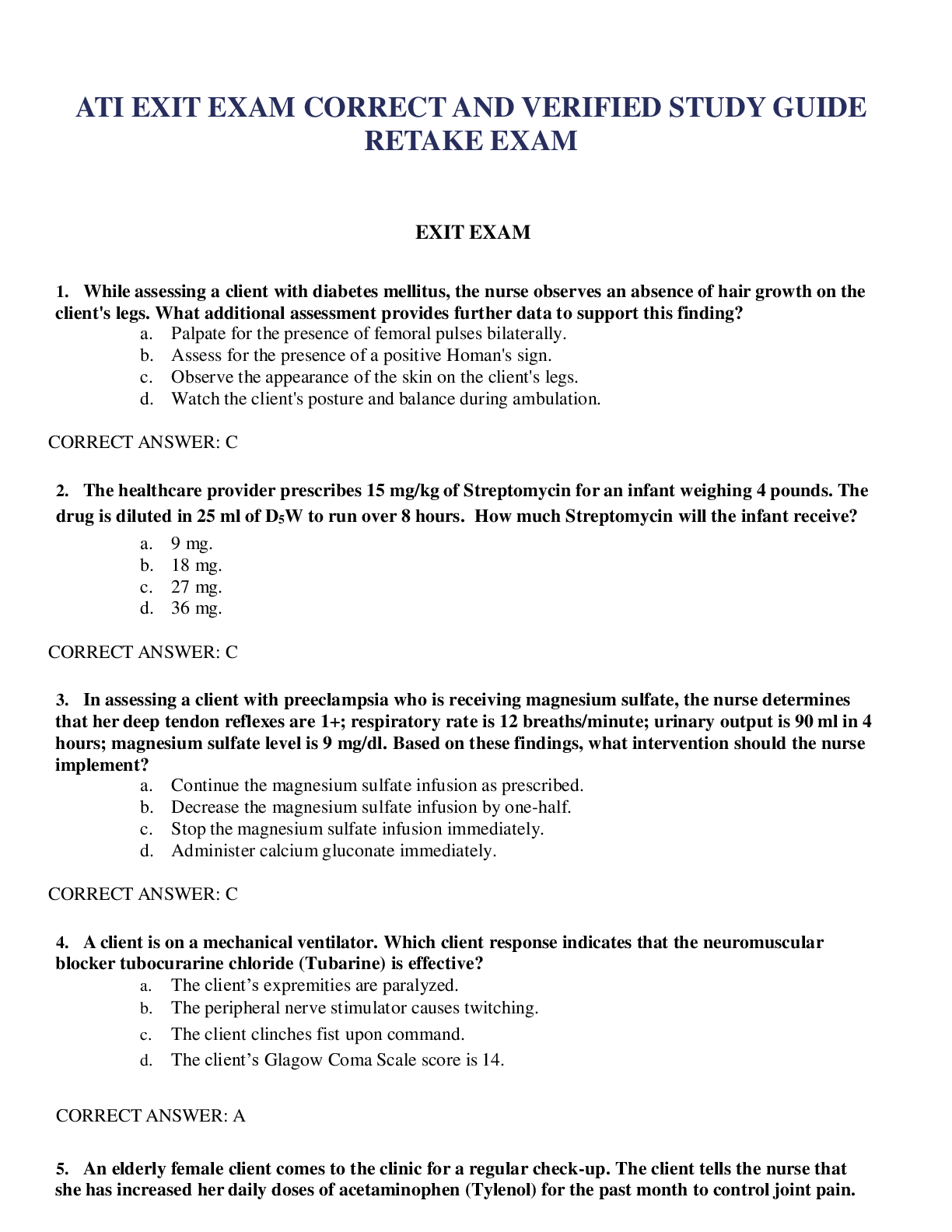

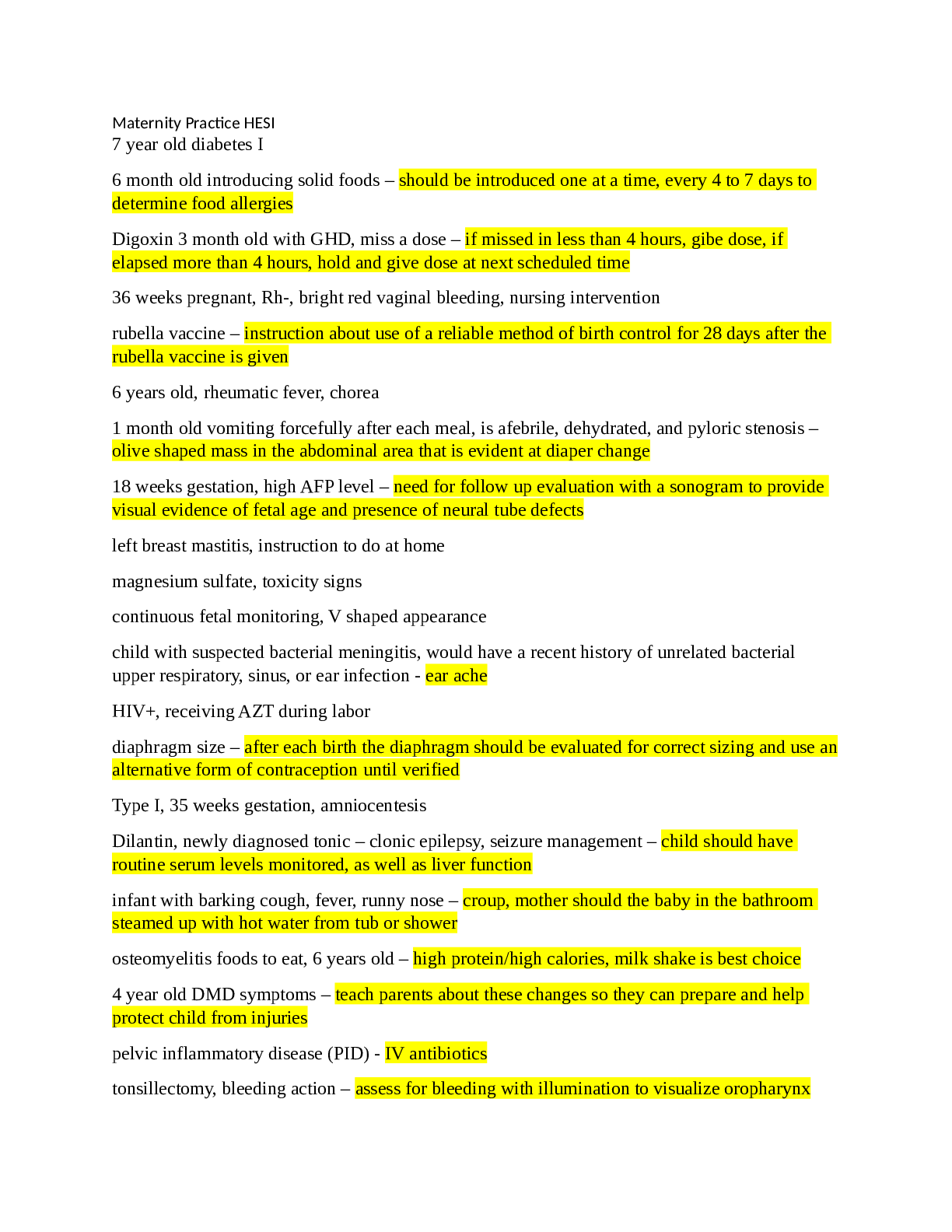




.png)

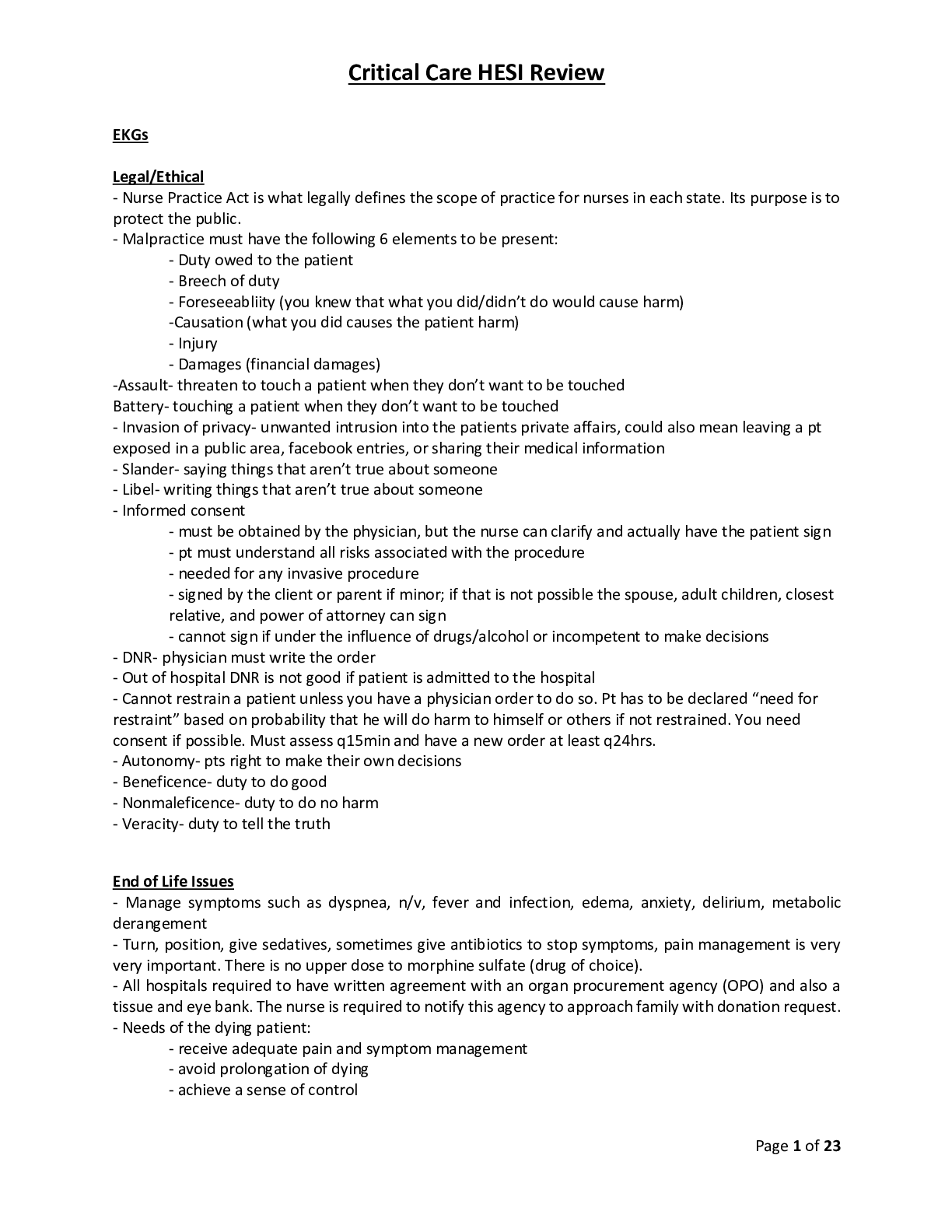
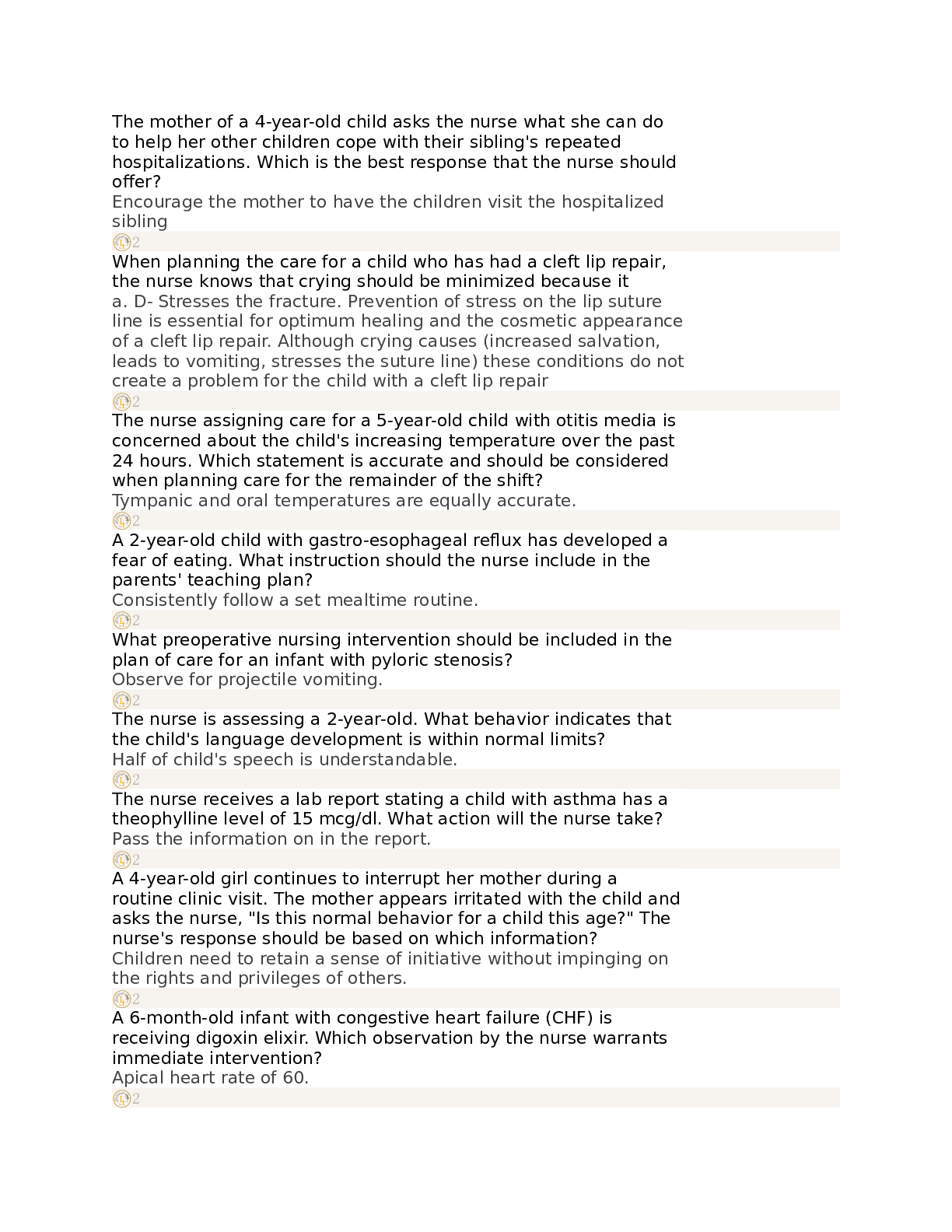
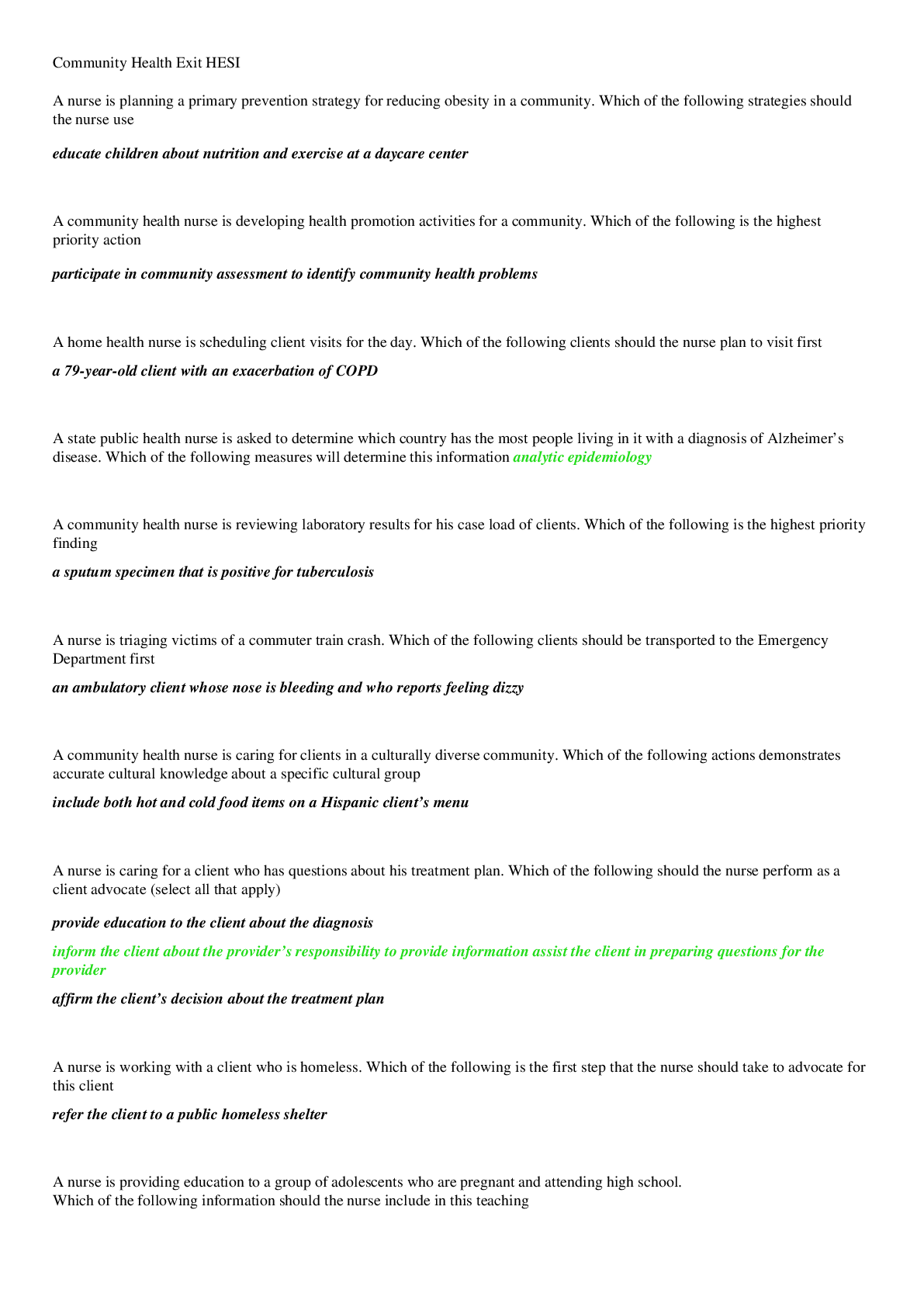
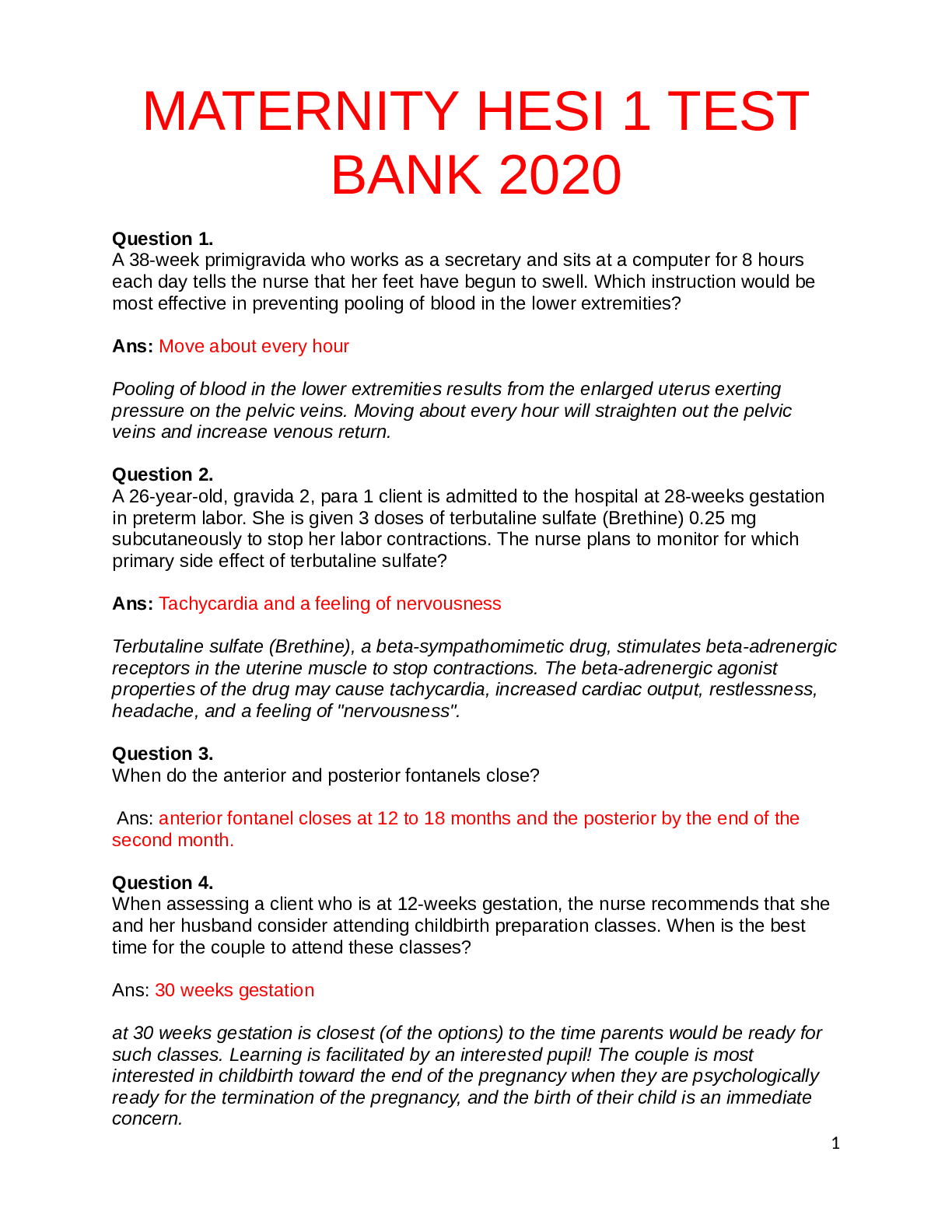


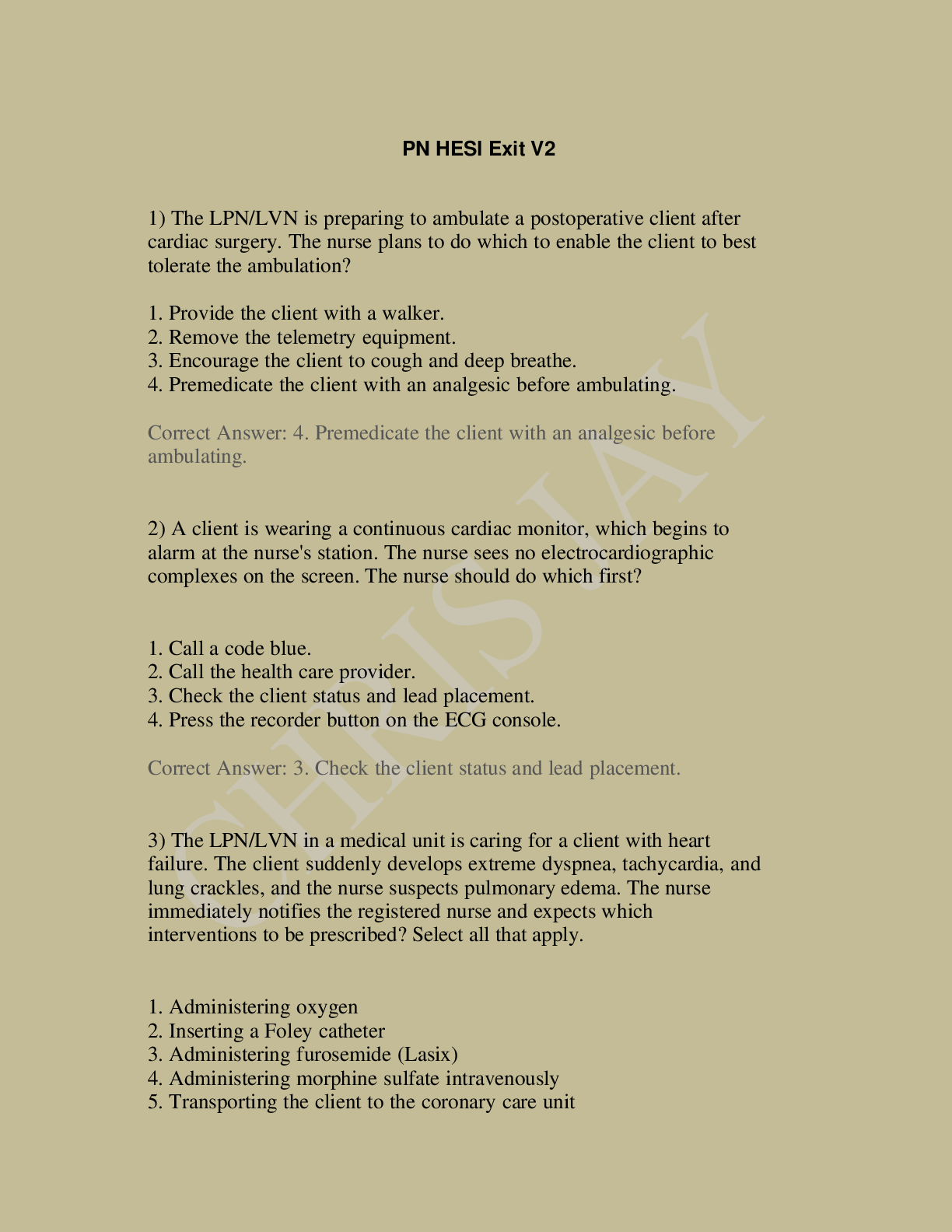



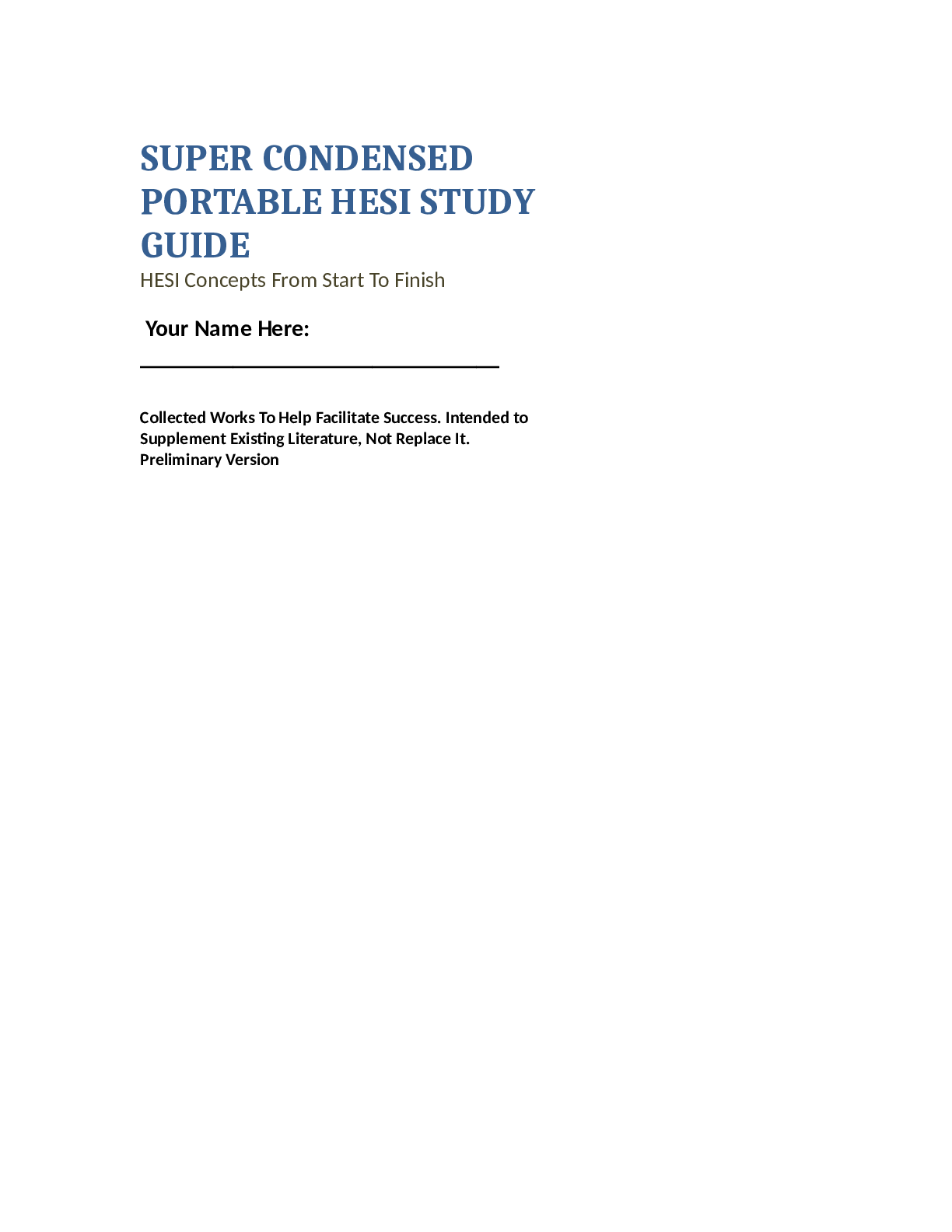




 (1).png)



